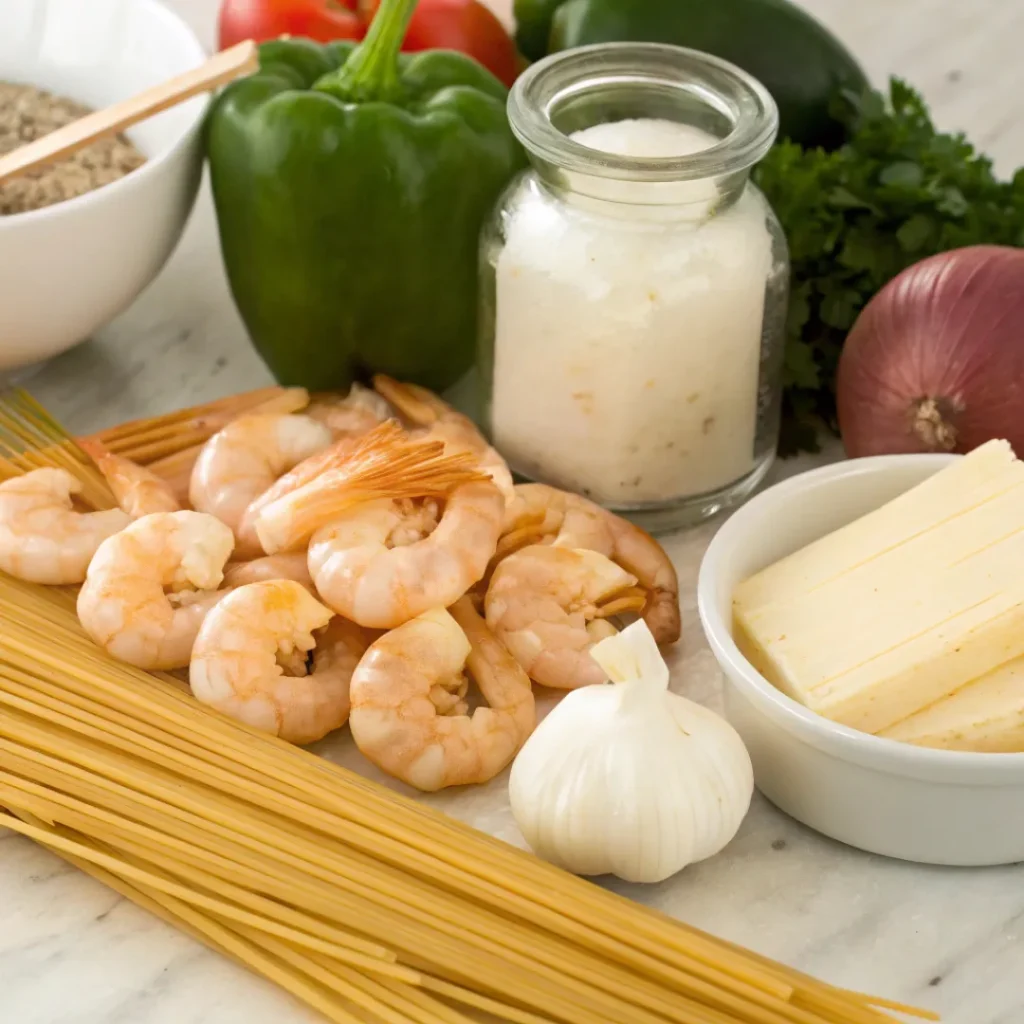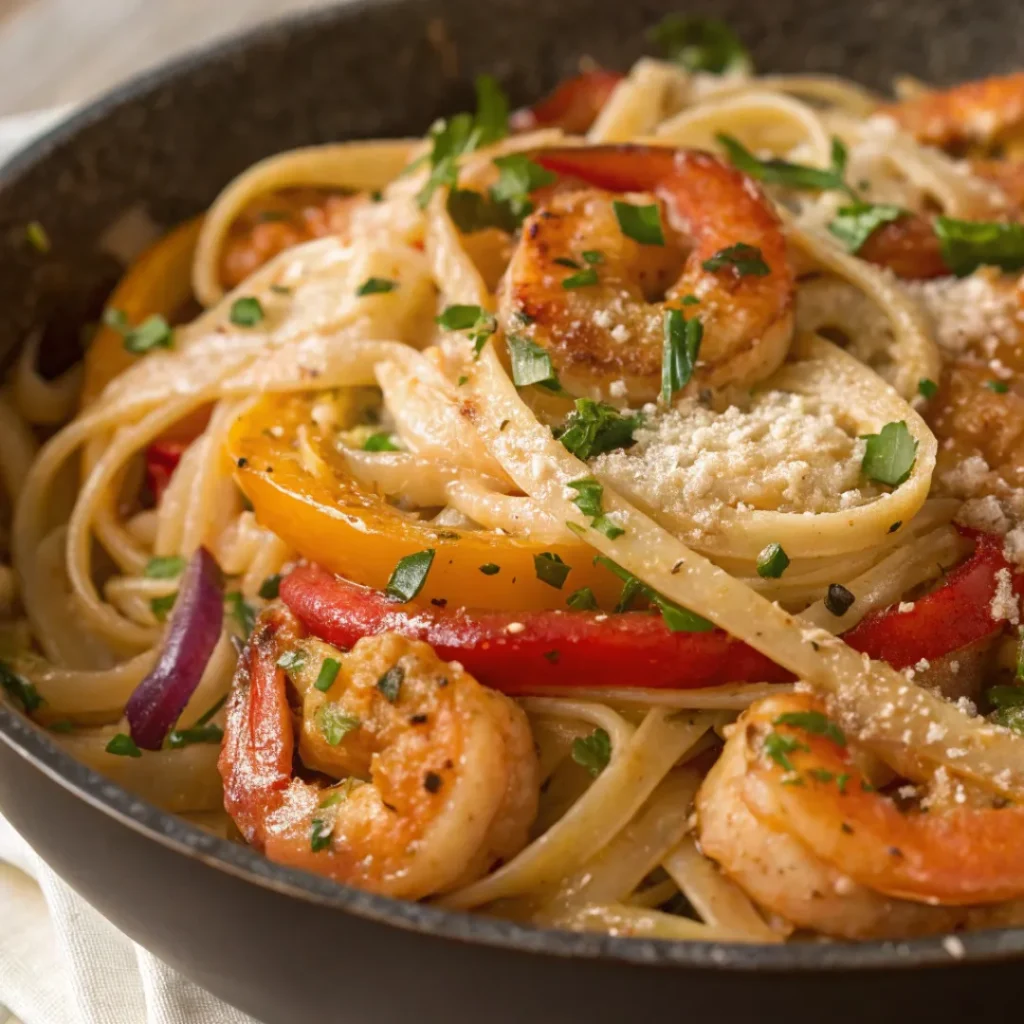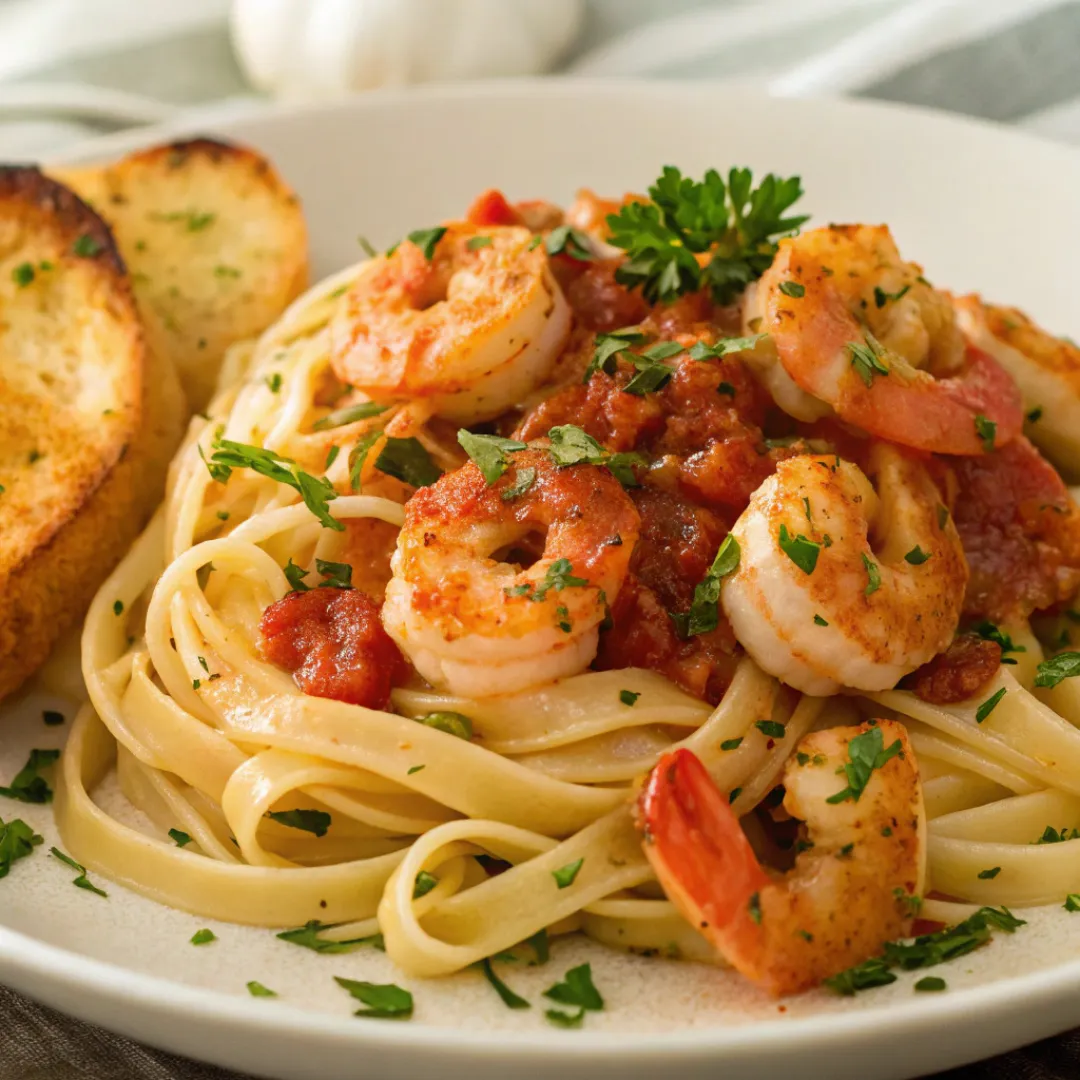Cajun Shrimp Pasta, famous for its bold flavors, creamy sauce, and tender shrimp nestled within perfectly cooked pasta, has a fascinating origin story. But where did Cajun Shrimp Pasta originate? This flavorful dish emerged from the rich culinary blend in Louisiana, where Cajun and Italian traditions came together.
In this article, we’ll explore how Cajun Shrimp Pasta was born, tracing its roots through the influences of Cajun cooking, Italian flavors, and the abundant seafood of the region. Join us as we uncover how this regional favorite transformed into a global sensation, beloved by food lovers worldwide.
What is Cajun Cuisine?
Cajun cuisine, at its core, is a rustic and flavorful cooking tradition born out of the resourcefulness of French-speaking settlers in the United States, particularly in Louisiana. The term “Cajun” refers to the Acadian people, who were expelled from present-day Canada in the 18th century and settled in Louisiana. Faced with a new landscape and limited ingredients, they developed a cooking style characterized by simplicity, heartiness, and bold flavors.
For a deeper dive into the flavors and dishes of Cajun cuisine, check out this Cajun Food Guide from The Manual.
Key Elements of Cajun Cuisine:
- Spices and Seasonings: Cayenne pepper, paprika, thyme, garlic powder, and black pepper are staples in Cajun seasoning, providing depth and heat.
- “Holy Trinity”: The foundation of Cajun dishes, this trio includes onions, celery, and bell peppers, adding depth and a natural sweetness.
- Seafood and Meats: Due to the abundance of freshwater and coastal areas, seafood—especially shrimp, crawfish, and catfish—became essential in Cajun cooking.
The Roots of Cajun Cooking in Louisiana
When the Acadian settlers arrived in Louisiana, they brought with them a French culinary heritage. Over time, they adapted to the unfamiliar environment, utilizing the locally available ingredients. With rich bayous and marshes, Louisiana offered abundant shrimp, fish, and other seafood, making it a natural addition to the Cajun diet.
The cooking methods they adopted were straightforward, often involving one-pot dishes that could feed large families. Dishes like jambalaya, gumbo, and étouffée showcase the versatility of Cajun cuisine and often incorporate seafood. This setting laid the groundwork for what would eventually become a fusion dish, leading to the Cajun Shrimp Pasta origin we recognize today.
The Role of Seafood in Cajun Cooking
Seafood holds a special place in Cajun cuisine due to Louisiana’s unique landscape of rivers, marshes, and the Gulf Coast. Shrimp, in particular, became a staple protein, cherished for its delicate flavor and versatility. Shrimp can be grilled, fried, stewed, or sautéed and pairs well with the bold spices and seasonings that define Cajun cuisine.
Why Shrimp?
- Availability: Shrimp has long been abundant in Louisiana waters, making it an affordable and accessible option.
- Flavor Absorption: Shrimp readily absorbs spices and seasonings, making it ideal for Cajun dishes.
- Quick Cooking: Shrimp cooks quickly, making it a perfect choice for fast, flavorful dishes.
The Influence of Italian Immigrants on Cajun Cuisine
In the late 19th and early 20th centuries, a wave of Italian immigrants arrived in Louisiana, particularly in New Orleans. Italian influence added new flavors and ingredients, such as tomatoes, garlic, and herbs, to Cajun cooking. Italian cuisine’s emphasis on pasta, cheese, and sauces blended seamlessly with the spicy, bold flavors of Cajun dishes.
The fusion of Cajun and Italian culinary techniques paved the way for pasta to become a part of the Cajun repertoire. Before long, Louisiana chefs began experimenting with combining pasta and Cajun flavors, leading to dishes that were rich, creamy, and filled with spices. Cajun Shrimp Pasta is a prime example of this creative culinary fusion.
The Birth of Cajun Pasta Dishes
While traditional Cajun cuisine did not include pasta, the Italian influence in Louisiana slowly introduced the idea. The creamy sauces used in Italian-American cooking worked well with Cajun spices, and pasta provided a hearty base for the rich, flavorful sauces characteristic of Cajun cooking.
Cajun Pasta Evolution:
- Creamy Base: A base made from cream or butter became popular in Cajun pasta dishes, balancing the heat from the spices.
- Spices and Shrimp: Shrimp was an easy addition to pasta, adding flavor and texture.
- Italian Pasta with Cajun Twist: Classic pasta shapes like fettuccine, linguine, and penne were combined with Cajun spices and seafood.
Why Shrimp is a Perfect Match for Cajun Pasta
Shrimp’s mild flavor makes it a perfect match for the bold, spicy profile of Cajun pasta. The tender, juicy texture of shrimp complements the creamy pasta sauce, creating a well-balanced dish. The Cajun spices enhance the flavor of the shrimp, making every bite savory and satisfying.
Key Ingredients in Cajun Shrimp Pasta
Each ingredient in Cajun Shrimp Pasta plays a crucial role in creating its distinctive flavor.

- Shrimp: The star ingredient, providing both flavor and protein.
- Pasta: Fettuccine or linguine is often used to hold the sauce.
- Cajun Seasoning: A blend of spices like paprika, cayenne, garlic, and thyme.
- Cream: Adds richness to balance the heat.
- Butter: Enhances flavor and adds a creamy texture.
- Garlic and Onions: Adds depth and enhances the Cajun profile.
- Bell Peppers: Adds sweetness and color to the dish.
How to Make Authentic Cajun Shrimp Pasta
To make authentic Cajun Shrimp Pasta, it’s essential to follow traditional Cajun cooking techniques. Use fresh shrimp if possible, and don’t skimp on the Cajun seasoning. Here are a few tips:
- Season Generously: Use plenty of Cajun spices to give the dish depth and a rich flavor profile.
- Sauté the Shrimp: Quickly sauté shrimp in a hot pan to achieve a slightly crispy texture.
- Creamy Base: Add cream or a cream substitute to create a smooth, luxurious sauce.
Different Variations of Cajun Shrimp Pasta
There are several variations of Cajun Shrimp Pasta, each adding its unique twist to the dish:
- Vegetable Cajun Shrimp Pasta: Adding vegetables like spinach, mushrooms, or tomatoes for extra flavor and texture.
- Cheesy Cajun Shrimp Pasta: Extra cheese, like Parmesan or mozzarella, makes the dish even more indulgent.
- Spicy Cajun Shrimp Pasta: For those who like it extra spicy, additional cayenne or jalapeños add a fiery kick.
Nutritional Value of Cajun Shrimp Pasta
While Cajun Shrimp Pasta is often seen as an indulgent dish, it also has some nutritional benefits:
- High in Protein: Shrimp is a good source of protein.
- Rich in Spices: Cajun spices, like garlic and pepper, have antioxidant properties.
- Contains Healthy Fats: Many recipes use a combination of butter and cream for richness.

Frequently Asked Questions
What is Cajun Shrimp Pasta, and where did it originate?
Cajun Shrimp Pasta is a dish that combines creamy pasta with Cajun-seasoned shrimp, bell peppers, and onions. It originated in Louisiana, influenced by Cajun and Italian culinary traditions. The dish reflects a fusion of Cajun flavors with Italian pasta, a result of Louisiana’s rich cultural diversity.
What makes Cajun Shrimp Pasta spicy?
The spice in Cajun Shrimp Pasta comes from the Cajun seasoning, which typically includes cayenne pepper, paprika, black pepper, and sometimes red pepper flakes. This blend of spices gives the dish its characteristic heat, balanced by the creaminess of the sauce.
Is Cajun Shrimp Pasta the same as Creole Shrimp Pasta?
Not quite. While both dishes share similarities and sometimes overlap in ingredients, Cajun cuisine typically uses simpler ingredients with a more rustic approach. Creole cooking, on the other hand, may incorporate tomatoes and has more French and Spanish influences. Cajun Shrimp Pasta usually relies on Cajun seasoning without tomatoes, while Creole Shrimp Pasta might have a tomato-based sauce.
Can I make Cajun Shrimp Pasta without dairy?
Yes, there are dairy-free versions of Cajun Shrimp Pasta. Instead of heavy cream, you can use coconut milk or a plant-based cream substitute. Many people find that these alternatives still deliver a creamy texture and complement the Cajun spices well.
Conclusion
The origin of Cajun Shrimp Pasta reflects the rich tapestry of cultures that have influenced Louisiana’s culinary landscape. This dish combines the rustic and bold flavors of Cajun cuisine with Italian pasta traditions, creating a meal that’s both comforting and exciting. Cajun Shrimp Pasta is more than just a dish; it’s a celebration of history, culture, and culinary creativity.
By exploring its roots, ingredients, and variations, we gain a deeper appreciation for this classic meal. Cajun Shrimp Pasta has come a long way from its origins, but it continues to captivate taste buds around the world with its unique flavor and cultural significance.

